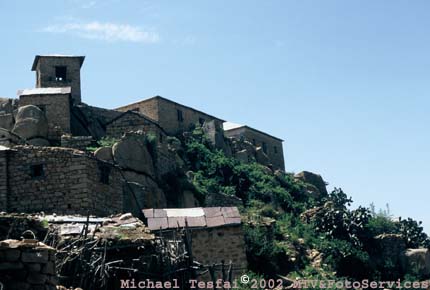Debre Bizen, otherworldly
and even Magical
| There are at least 18 monastries in Eritrea. Following the raids of the
famous Muslim leader, Mohammed Gragn the left Handed, in the 16th century
almost all of them were safely tucked away in very remote and inaccessible
places. |
|
Three of the oldest and most important are Debre Bizen (near Nefasit),
Hamm (near Senafe) and Debre Sina (near Keren).
High upon a mountaintop, hundreds of meters above the road, just 25
kilometers from Asmera, its rough-hewn stonewalls mounded into the sheer
drop of the cliff, stands a 600 year old monastery, Debre Bizen.
Just beyond the outskirts of Asmera, the smooth plateau, on which the
city is built, crumples into dramatic folds of steep valleys and towering
mountains. It is on the very summit of one of these mountains that for
600 years Debre Bizen has stood, hundreds of meters abouve the road, molded
into the very face of a sheer cliff. The ammosphere of the settlement,
surrounded by a groove of rare indigenous trees, is pious and medieval,
otherworldly and even magical.
|
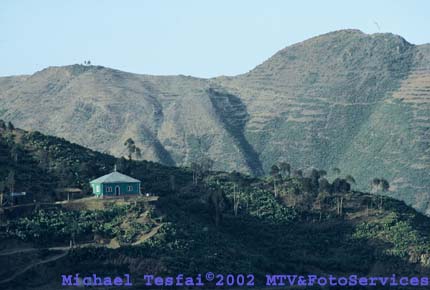 |
Just beyond the outskirts of Asmera,
the smooth plateau, on which the city is built, crumples into dramatic
folds of steep valleys and towering mountains. It is on the very summit
of one of these mountains that for 600 years Debre Bizen has stood, hundreds
of meters above the road, molded into the very face of a sheer cliff. The ammosphere
of the settlement, surrounded by a groove of rare indigenous
trees, is pious and medievvl, otherworldly and even magical.
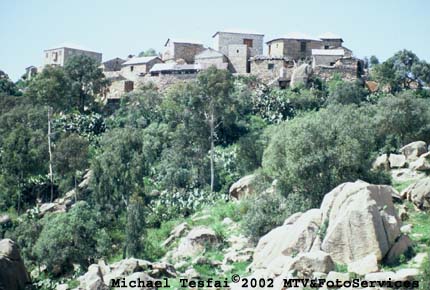 |
The spot commands magnificent views of the surrounding hills and all
the way down to the line of the Red Sea coast,
2, 400 meters below. At night the lights of Massawa sparkle in the
distance. In the day the air is cool, there are birds signing and green
grass grows between the monastery buildings. At dawn a carpet of glistening
white cloud often hides the earth below where the village of Nefasit with
its yellow and green-domed mosque and a coptic church nestles at the base
of the mountain.
The monastery of DEBRE BIZEN, the most prominent beacon and symbol of
Christianity in Eritrea, perches high above the village mysteriously wrapped
in thick cloud. Legend and history enhaces its sense of mystery and magic.
For centuries it has survived as a center of Chiristian prayer and a learning
in spite of invading armies and religious conflicts.
|
[FOTO]Abune Filipos, a pupil of Abune Tatyos, founded the present monastery
in the early 14th century although a center existed on the site even before
Filipos´ birth. Many legends surround the founding monk, who was considered
so holy that his shadow allegedly cured three cripples.
His teacher, Tatyos, is also the subject of legend. During his evangelical
journey eastwards, he asked a captain to take him across the Red Sea. The captain
asked for money, but Tatyos had none. The story continues how Tatyos therefore
resorted to sitting on his cloak, which bore him up like a magic carpet and
flew him across the seas and deserts to Armenia.
| He supposedly launched hmself from a rocky ledge, north of
the monastery, called Iney Kbetsni,
"Goodbye My Mother". It is claimed that the gnarled tree which
stands on the wind-blown rock today is the one which bowed down to the pious
monk as he prepared to launch himself into the skies.
Behind the outcrop, Iney Kbetsni
is a tomb dedicated to Abune Yohannes, an abbot of the monastery who lived
five hundred years ago.
Iney Kbetsni
was and maybe is still manliness evidence. Every now and then men tried
to climb on the tree which hungs in a very dangeraous cliff and wanted
to be fotographed as a proof and want to show off that they are courageous
and brave. They used to say if one loses balance on the tree and falls
down the gorilas down there will be happy for having a lunch/dinner.
|
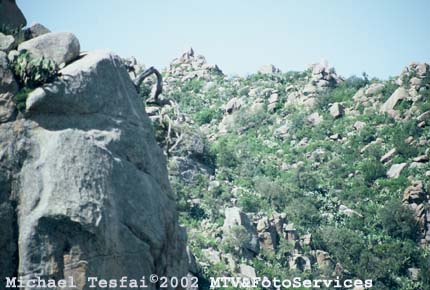 |
| The monastery itself is a collection of pink granite buildings, cut into
the sides of huge smooth rocks. The oldest building is the round church
built during the lifetime of Filipos. The church now has a corrugated iron
roof, which replaced that of reeds or grass. On top of the roof is an intricate
Orthodox crucifix and a circle of bells which jangle in the breeze. The
walls of the church are painted yellow, with decorated wooden shutters and
door. |
The compound of the church is planted with an African species of olive, which
looks similar to the European and Middle Eastern kind cultivated for oil, butis
quite wild. There is also a church with a bell tower, a solid, square-looking
mansion for the patriarch, a pilgrims´ guesthouse with arched doors, monk´s
cells, kitchen houses and a brewery.
To the east of that is a modern church and next to this is the house of some
1,000 ancient manuscrips for which Debre Bizen is justifiably famous. Several
dozen fine illuminated parchments bound in thick leather, cloth and even wood,
are stacked in this archive. In the archive open to visitors there is the most
extraordinary bible allegedly dating from 14th century, the period of Abune
Filipos´ lifetime.
Another exquisite manuscript is the lost biblical Book of Enoch, and a third
the story of Abune Libanos, a great chuchman who traveld from Lebanon and found
the monastery of Debre Libanos in Eritrea´s southern highlands.
The manuscripts are examples of the finest medieval workmanship, meticulously
written in the liturgical languageof Ge´ez in red or black inks with elaborate
illuminations. A bell is rung whenever a manuscript is removed from the library,
which is rare because the monks tend to read on the spot.
To reach the monastery you must make an energetic climb up a steep mountain
slope. As you climb higher up the stark, eerie cliffs, you feel that the Holy
Grail of an Arthurian romance, the Ark of the Convenant or some revelation must
exist for the weary pilgrim at the end of this road.
In contrast it is sobering to see groups of little children sprint up the path
and totter down under large loads of cactus fruit.
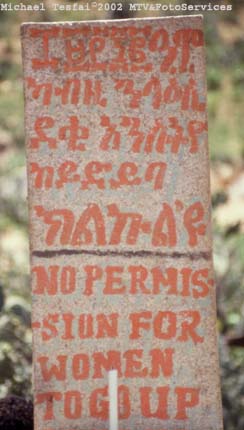
|
Along the steep path a large cross marks the point at which women stop
and proceed no furhter.
At Debre Bizen, the rule is taken to extraordinary lenghts. Not even female
animals are allowed near,
meaning only mules and male donkeys are used as pack animals. Abune Filipos
supposedly declared
he would rahter stare into the face one of the lions
- which at that time inhabited the wild mountain - than look into the
eyes of a woman.
A Legend says that an Amrican woman dressed as a
man (for sure in jeans, striped shirt,
snickers and a base ball cap) tried to cross the line and was blown up
by the wind and no
one knows her whereabouts.
|
The monks, who today number more than 100, live in an egalitarian
society, wearing the same clothes and eating the same food whatever their
rank. They also offer a charitable refuge for handicapped, old and destitue
men. The monks survive
on rainwater collected off the guttering of the roofs, and use solar power
cells to generate electricity to run their bulbs.
The blackened interior of their kitchen is an impressive place, containing
vast cooper pots, which are large enough to cook three cattle at once. And
indeed a huge amount of cooking is done during teh festivals at the monastery,
when thousands of male pilgrims make their way up the mountain. A sorghum
beer called Swa is also brewed for these occasion in a stone congress hall
next to the kitchens. In another neighboring hall is a large timber beam
used as stocksfro punishing wrongdoers in the monastery. |
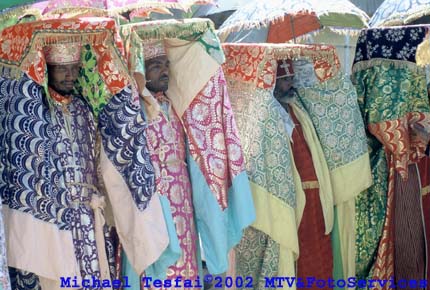 |
Pilgrims and visitors are housed in a guesthouse with arched doors. Outside
is a trough carved out of huge stone, which the monks claim, was carried on
the back of one of Filipos´s pupils. Today it is used for bread making.
Practical reality combined with piety, myth and mytery make Debre Bizen a unique
religious retreat. And as one gazes across the crumpled folds of craggy mountains
from the outskirts of Asmera to the remote mountain monastery, it is not difficult
to believe that it will continue to survive unscathed for many more centuries.



